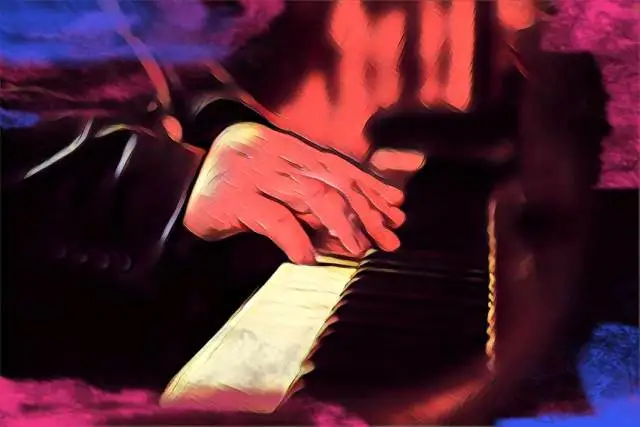Everyone likes to mix things up from time to time. Whether it’s a new haircut, or a lick of paint in your studio, subtly altering the background of our life is human nature.
And music is no different. Reharmonization can radically alter a song, or subtly change its tone. It allows you to add depth and creativity to familiar tunes, and can be an excellent tool when writing.
We’re going to be looking at specific reharmonization techniques to open up the harmonic possibilities on your musical journey.
Let's start by taking a look at what reharmonization actually is.
What is Reharmonization?
Reharmonization is the process of changing the harmonic structure of an existing song.
Or, to put it another way, you change the chord progression of a song while maintaining the exisiting melody.
Is Reharmonization the Same as Chord Substitution?
Well, yes and no. The technique of reharmonization does involve substitution, but it's applied to an entire chord progression, rather than a single chord.
Typically substituting a single chord is used to spice up a song, whereas reharmonization is used to radically alter it.
Is Reharmonization Only Used by Jazz Musicians?
Reharmonization is a staple of the jazz diet, for sure. But it can be applied to any style of music.
Why Use Reharmonization?
There's many reasons to reharmonize a song, and benefits from learning how to do so.
Musical Interest
Reharmonization can add musical interest to existing songs, or a repeated section within the structure of a song. Let's face it, even the most fun chorus can get tired when you hear it over and over again.
Versatility
The reharmonization of a song can make it more suitable for different situations. For instance, you could reharmonize a song by Nirvana to make it fitting for a wedding reception.
Creativity
Reharmonization opens up new musical landscapes and ideas. Hearing a familiar tune in this new way can inspire other musicians to explore new territory.
Emotional Complexity
Reharmonization can a dramatically change the emotional qualities of a song, making it more resonant for the audience.
Add a Personal Touch
If you're covering songs by other artists reharmonization can add individual flair to your performances.
Showcase Your Artistic Skill
Reharmonization is an excellent way to showcase your versatility and skills as a musician. In a live situation it's a fantastic way to surprise and delight an audience.
Understanding
One of the big benefits of learning reharmonization techniques is a deeper understanding of music theory. You begin to learn how all the pieces of the puzzle fit together, and this can breathe new life into your own music.
Basics of Reharmonization
Before we look at common reharmonization techniques it's important to understand the foundational elements that will help you reharmonize effectively.
Key Melody Note
This is the note (or notes) in each measure around which you'll build the new chord structure. The new chords will compliment the key melody notes by adding emotional depth or complexity.
Harmony
This is the chord progression that supports the melody. During reharmonization you need to choose chords that not only fit with the melody note, but that also follow their own logical structure.
If you're unfamiliar with how chords work it's worth brushing up your skills before you start reharmonizing.
Rules for Reharmonization
In order to reharmonize a song you'll need to a) know the melody inside out; and b) know the original chord progression.
It can also be helpful to decide beforehand how often you're going to change chords - known as the harmonic rhythm.
You might decide to use the original chord progression and just switch out the chords, or you may change chords more, or less often than the original.
Knowing this will help keep a logical structure to your new chord progression as you create it.
Common Reharmonization Techniques
Modify Existing Chords
A simple reharmonization technique is to modify the original chords slightly. For example, take a C major chord and make it a C major 7th, or take an F chord, and make it F7.
For a more jazzy sound consider adding extensions to the chords. Extended chords are basic triads with added tones on top (the extensions). Chord progressions with 9th, 11th or 13th chords are familiar territory to jazz musicians, but they're extremely useful in all genres of music.
Using chord extensions allows you to introduce different chord types that still sound good under the original melody.
Change Chord Voicings
Similar to the above, changing the voicing of a chord can be a simple yet effective way to adjust the chord quality.
A chord voicing is how the different notes of a chord are spaced out across the musical spectrum. At its simplest a chord has the root note at the bottom, with the other tones stacked immediately on top. Spacing these notes out in different ways creates different chord voicings.
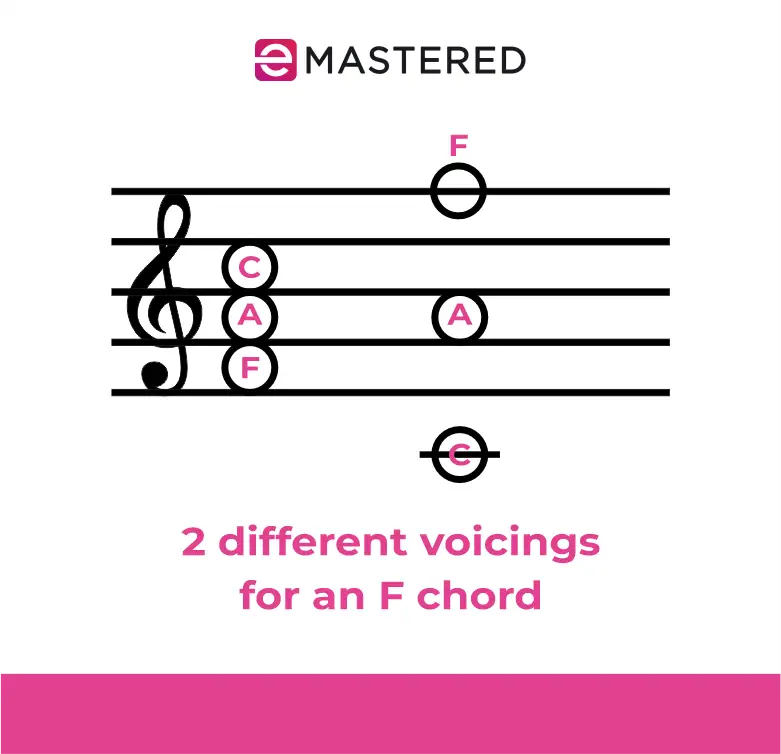
Changing a voicing can significantly alter the chord quality, but doing it effectively requires some theory know-how !
Diatonic Chord Substitutions
Substitution is the technique of replacing a chord with another one that has a similar, or the same, harmonic function.
For example, a C major chord (C-E-G) could be substituted with A minor (A-C-E) or E minor (E-G-B), as both of these chords share two common tones with C.
You can do some exploring here. Once you know the key of the song, work out all the diatonic chords within it, and play around to see which ones work under the key melody note.
Use a Bass Pedal Point
A pedal point note, usually played by the bass instruments, is a note that sustains while the harmony changes above it.
Using a pedal note in the bass line will create a smooth transition in the harmony, yet still bring tension into the music. A great example of a pedaled bass line is during the intro to Van Halen's Jump .
When using a pedal the bass line will start with a common tone from the chords, before become a non-chord tone under the changing chords.
Change the Musical Mode
If the song undergoing reharmonization is in a major key, try shifting it to the relative minor key, or vice versa.
To find the relative minor of a major scale, count 3 half steps down from root note. For example, if the original song is in F major, count down 3 half steps and you land on D. So the relative minor is D minor.
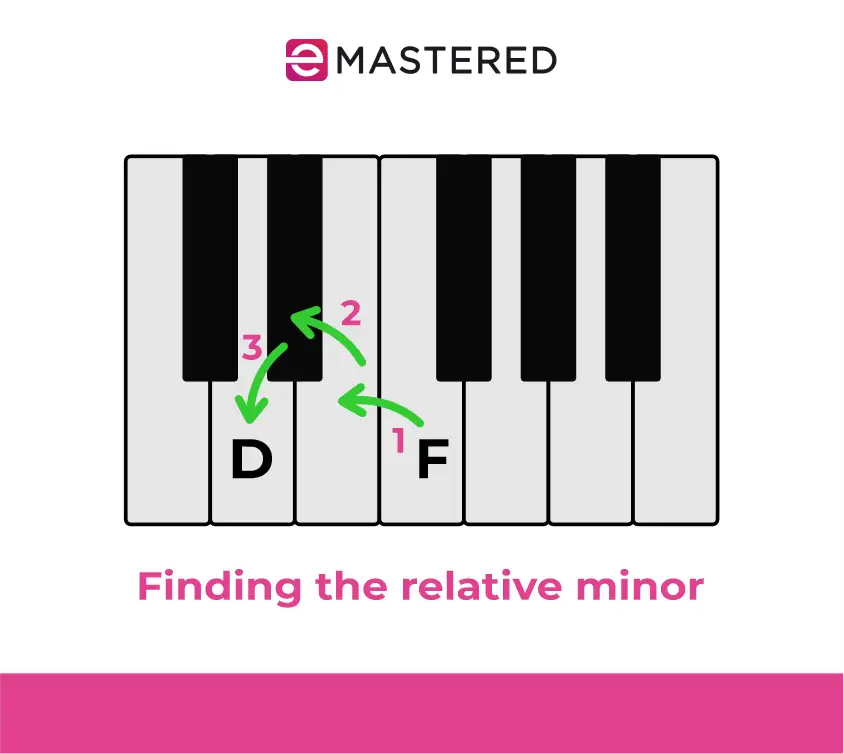
Now you can make the song sound all sad and moody!
A more harmonically complex version of this method is to put the reharmonized version of the song in a different mode entirely.
Keep in mind if you use this method you may need to alter some notes of the existing melody to match the scale tones found in the mode.
Use Borrowed Chords
Another reharmonization technique that is super-effective is the use of borrowed chords . These are chords from a mode or key different than the one the song is originally in.
For example, you could borrow from the minor mode and use a minor chord in place of a major one - replacing a IV for a minor iv. In the key of C, F would be replaced by F minor.
But you can go much deeper than just the minor mode. By utilizing other modes you can introduce all sorts of new colors and tension into the music.
Just be sure that it sounds good against the the melody note playing above the chord!
Examples of Reharmonization
It's all well and good talking about reharmonization techniques, but what does each one sound like?
Let's take a look at each of the above in practical terms using my cat's favorite tune, Twinkle Twinkle Little Star .
Let's start off looking at the rules of reharmonization in terms of the tune. Here's the original melody in C:
| C C G G | A A G | F F E E | D D C |
And here's the key melody notes for each measure:
| C G | A G | F E | D C |
For the harmony, the chords are pretty straightforward:
| C | F C | F C | G C |
And for reference, here's what the whole thing sounds like:
Now, let's get down to business!
1. Modifying Existing Chords
Let's keep things simple for the first example. Following the chord structure of the original, I'm going to add notes to each chord to give a slightly jazzy sound to them.
The new chords will be:
| Cmaj7 | Fmaj7 Cmaj7 | F6 Cmaj7 | G7 C |
And here it is in piano roll format:
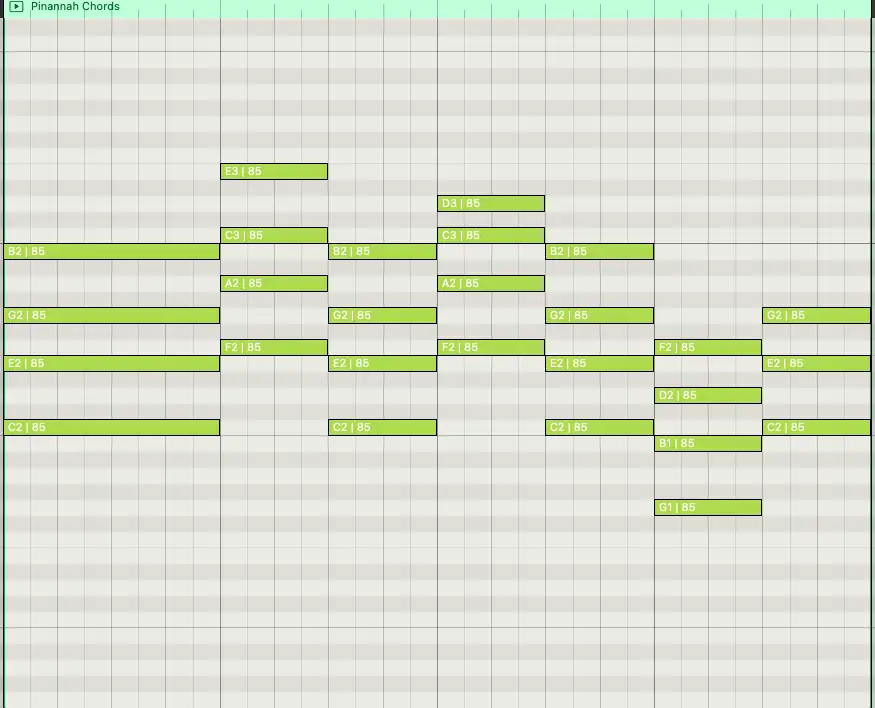
In the third measure I opted to use F6 rather than Fmaj7. This is because the major 7th of the F chord (E) would clash with the key melody note of that measure (F).
2. Change Chord Voicings
Even with the additional notes in the chords, things still sound a bit stilted. That's because all the chords are in root position; pretty boring stuff.
Keeping the same progression as above I'm going to change the voicing of the chords so they look like this:
| Cmaj7 (C-G-B-E) |
| Fmaj7 (C-F-A-E) Cmaj7 (C-G-B-E) |
| F6 (A-F-A-D) Cmaj7 (G-E-B-C) | G7 (G-D-F-B) C (C-E-G-C) |
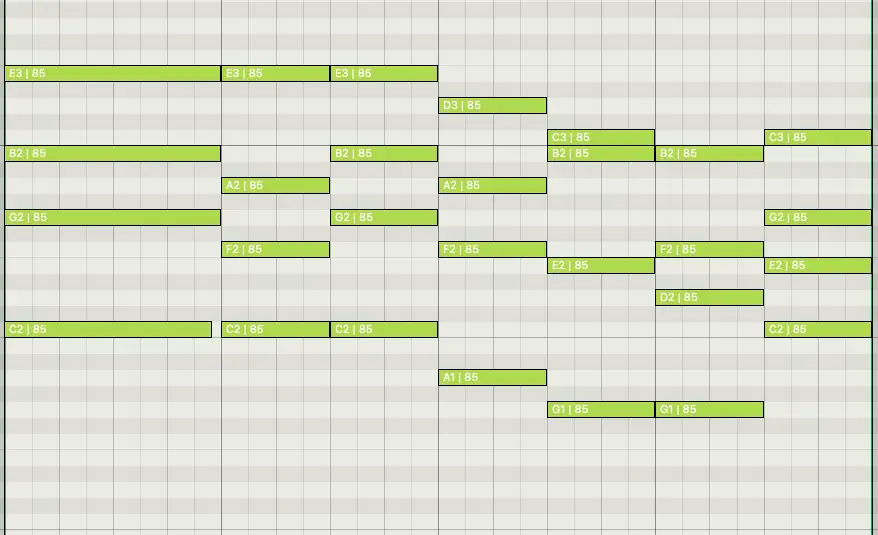
And here's what it sounds like:
3. Diatonic Chord Substitutions
Next, let's take a look at all the other chords we could possibly use. We're in C major, so the diatonic chord options available to us are:
- C major (C-E-G)
- D minor (D-F-A)
- E minor (E-G-B)
- F Major (F-A-C)
- G Major (G-B-D)
- A minor (A-C-E)
- B diminished (B-D-F)
I want to keep the harmonic structure already set up, and I also want to make sure the new chords don't clash with the melody note they play under.
KEY MEDLODY NOTE: | C G | A G | F E | D C |
ORIGINAL CHORDS: | C | F C | F C | G C |
I won't switch out every chord for a diatonic alternative, but I will use some of the minor chords available to me, in order to create some tension in the back half of the melody.
Let's also mix and match some ideas from the first technique, to give us:
KEY MELODY NOTE: | C G | A G | F E | D C |
NEW CHORDS: | Cmaj7 | F Em7 | Dm7 Am7 | B° C |
The B diminished chord functions as a dominant chord, replacing the G in the original.
4. Bass Pedal Point
This one's a doozy! I'm going to keep the original chords and pedal a C in the bass throughout.
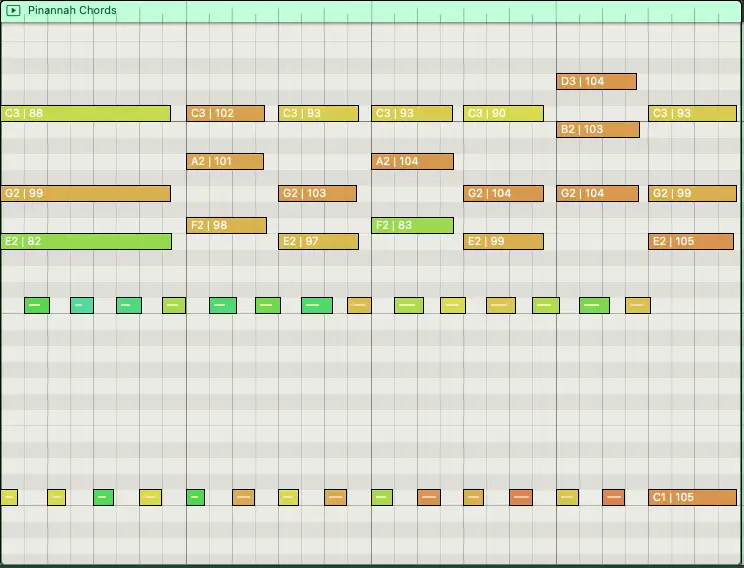
The note C is common to both the F and C chords; the tension comes when we hit that G chord at the end while the bass is still pedaling a C.
Note that I've also used inversions on the chords so the top note of each chord also creates a pedal point.
5. Change the Musical Mode
For this technique let's switch from C major to C minor. Because the scale has changed we'll also have to adjust a melody note here and there:
Original Melody: | C G | A G | F E | D C |
New Minor Melody: | C G | Ab G | F Eb | D C |
In this example the C and F major chord become a minor chord.
Minor Chords: | Cm | Fm Cm | Fm Cm | G Cm |
6. Use Borrowed Chords
We can get really creative with this technique! Since we're in C major let's look at all the chords available to us in every different mode:
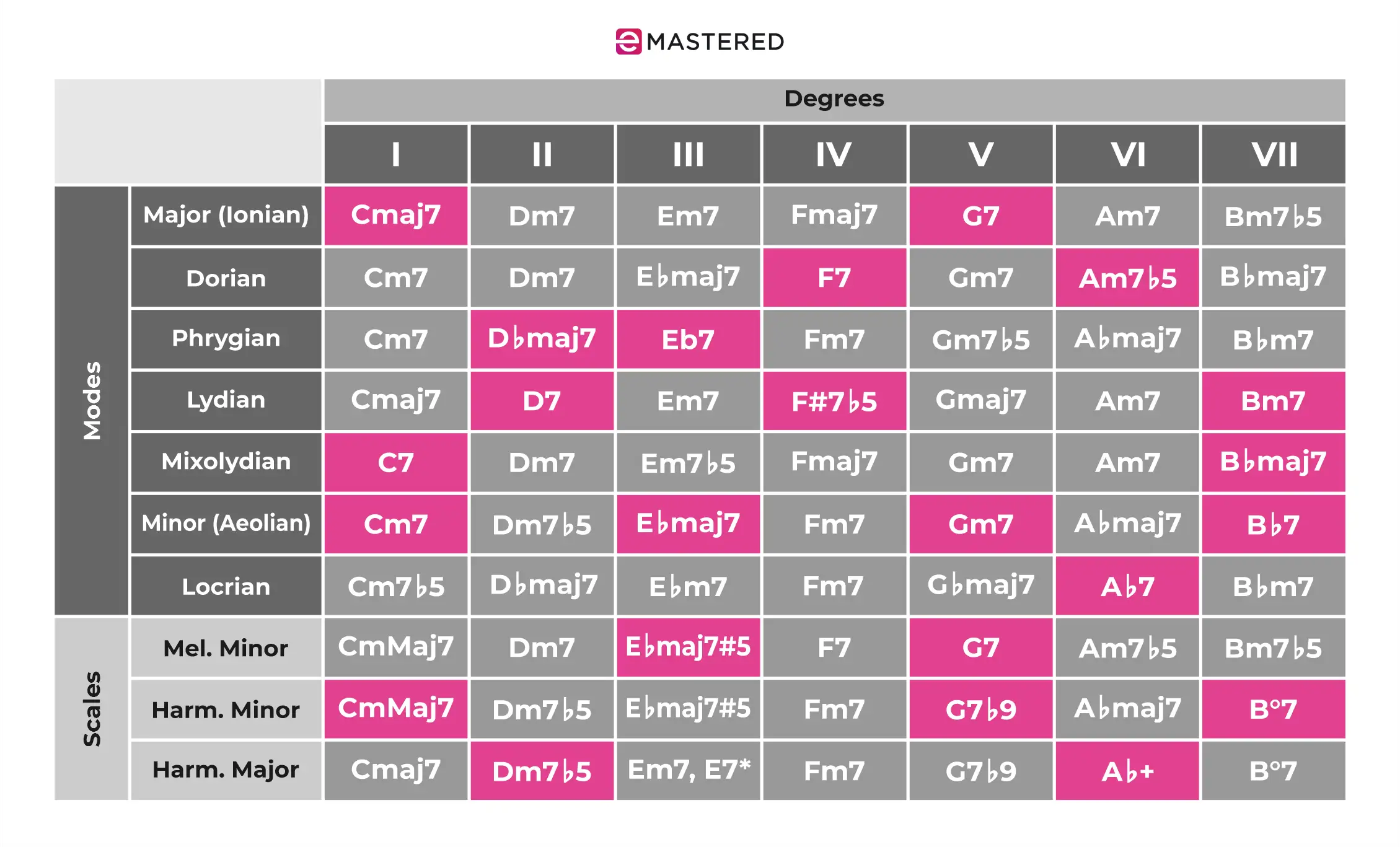
I'm going to add a chord in the first measure, replace the chords in the remaining measures, and add some movement to the harmonic structure:
ORIGINAL CHORDS: | C | F C | F C | G C |
NEW CHORDS: | C Em7 | Bbmaj7 Ebmaj7 | Gm7 Gbmaj7 Fmaj7 D7/9 | Dm7 G7b9 C |
You'll notice in the last measure I've used a D7/9 - an extension of D7. There's no rules against mixing and matching different reharmonization techniques!
It's a little overkill on the borrowing front, but you can hear how much richer the harmony is:
Tips and Tricks for Reharmonization
Study music theory - it'll be your best ally when working out new chord progressions.
Always pay attention to the key melody note! Tension is great and all that, but be careful of creating too much!
Listen and analyze other songs that have been reharmonized, along with the original. Pay attention to how much has been changed, and the effect it has on the music.
Start simple and build up your reharmonization techniques over time.
Don't over-do things . Just because you can use borrowed chords throughout the chord progression doesn't mean you should. Think about the chord qualities you're replacing, and what effect you want to create.
Conclusion
And here endeth today's lesson.
While there is a whole lot more to learn in order to master the art of reharmonization, you don't need to be a jazz musician to go on your own reharmonization adventure! Armed with these tips and techniques you can start exploring how to breathe new life into your favorite songs.
Now go forth and reharmonizeth the music!


